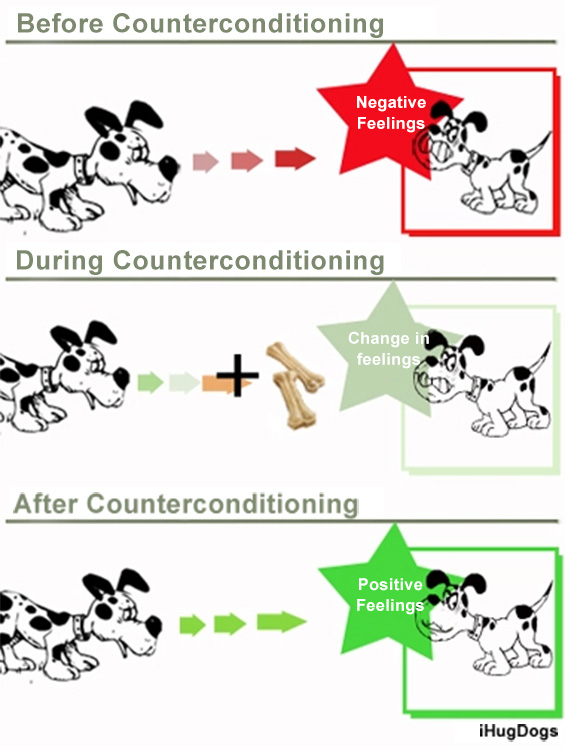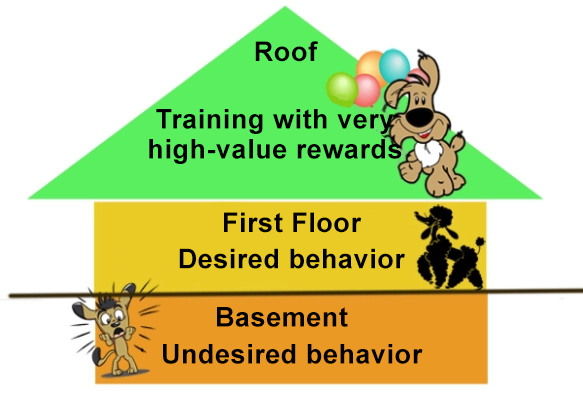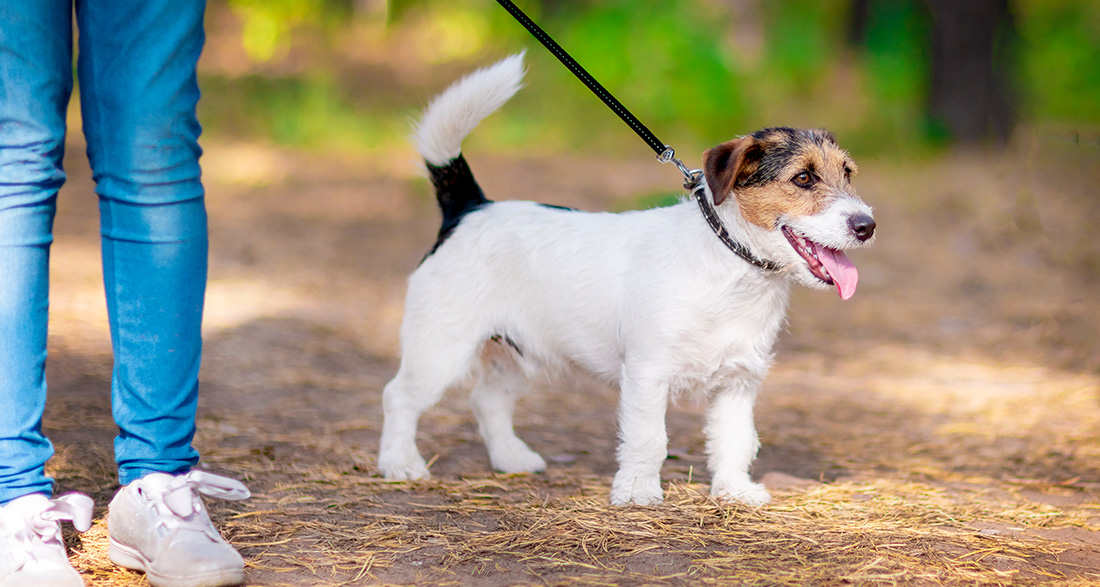Counterconditioning and desensitization—both aimed at changing emotions and paving the way for new behavior.
Counterconditioning
Imagine your previously leash-aggressive dog looking forward to the encounter of other dogs in the future. Don’t believe it’s possible? Be surprised, as there’s no magic behind it.
Once again, we make use of classical conditioning here. With this, your dog learns that another dog is a signal for something great from you. Instead of resorting to attack or escape, it will look forward to the arrival of the other dog.

So, the principle of counterconditioning is quite simple: EVERY TIME your dog sees another dog, it’s party time with you. Regardless of whether it would react to that dog or not. Also, regardless of the behavior your dog is exhibiting at that moment.
It doesn’t matter if you toss treats, start a fun game with your dog, or race with it. The main thing is that your dog enjoys it, and you maintain the high value of the reward throughout the training.
Of course, you start the training as always at a sufficient distance and use management measures for unexpected encounters that you’ve established beforehand. And if you also use a marker, your dog will quickly understand that other dogs trigger the party. Before long, it will look at you and wait for the party when it sees another dog. That’s the big moment that deserves a proper celebration.
And as this happens more often, you can gradually increase the difficulty and build appropriate alternative behaviors.
That’s basically it. However, I recommend having a trainer by your side the first time you work with counterconditioning. They will help you avoid dead ends and mistakes from the beginning. Like everywhere else, even here, the smallest details sometimes matter. But they will also encourage you when things don’t go perfectly.
You see, counterconditioning is about changing feelings and emotions positively. Only later is the focus consciously placed on changing behavior. Counterconditioning lays the foundation for this. Because only when your dog feels good is it able to engage with your behavioral offerings.
Counterconditioning — Almost Limitless
Because, of course, counterconditioning is not only helpful in dog encounters but everywhere emotions and their changes are involved, such as with:
- Fears of objects, living beings, or sounds
- Negative stress triggers (grooming, veterinarian, smells…)
- Positive stress triggers (start of a walk, arrival at the training ground, food preparation…)
- High positive or negative arousal (other dogs, balls, doorbells…)
…
Counterconditioning Takes Time
No one can tell you how long counterconditioning will take. The progress depends on too many factors. However, you will see that initial successes occur quickly, which, in turn, motivates you to continue. And even if there are moments later when your dog reacts, it will definitely become more responsive again.
Counterconditioning also works with older dogs. For example, my first dog came to us at the age of 7 1/2 with many fears and panic about loud noises. Thanks to counterconditioning and subsequent desensitization, he got to experience a few more beautiful and anxiety-free years with us.
But it also works for dogs who are so excited about other dogs that they can’t cross paths calmly.
And yes, there are dogs for whom counterconditioning does not show the desired effect or takes a very long time. These are usually dogs with health issues, traumas, and the like. Therefore, a health examination (general and blood tests, plus physio and/or osteo) must always be conducted before or simultaneously with the start of training.
How To Reward Correctly
I like to compare counterconditioning to a house consisting of a basement, ground floor, and attic. Undesirable behavior occurs in the basement, the dog exhibits normal, desired behavior on the ground floor, and we party in the attic.

If you only reward/pick up your dog in a way that it goes from the basement to the ground floor, it will end up in the basement again with every relapse, practicing its old behavior there.
Thanks to counterconditioning, however, we’ve reached the attic. And if it falls down from here, there’s a very high chance that it will stop in the ground floor or at least not take all the basement stairs again.
I deliberately speak of rewarding. Because if we do it right, the dog is rewarded for (just) remaining calm when the trigger appears. Later, it’s rewarded for actively turning to us. And if we also use the marker, the dog will realize this faster than if it “only” gets the reward.
Counterconditioning – A Lifelong Journey?
No, of course, you don’t have to celebrate parties at dog encounters for a lifetime. But what’s wrong with praising your dog for good behavior and occasionally rewarding it? Especially when the encounter was challenging.
Once the behavior in the attic is stable in as many situations as possible, you can start gradually phasing out high-value rewards and switching to less valuable ones. Because the long-term goal is normal behavior. However, for refreshment or during challenging encounters, high-value rewards should still be used.
Because, just as we expect and receive pay for our work, the dog also has the right to be noticed and rewarded for its good behavior. And especially in dog encounters, this is easily achievable.
It becomes more challenging only when the trigger comes unexpectedly, and you are not prepared for it. Or with all triggers that appear in your absence. Here it makes sense to:
- Teach your dog an alternative behavior with which it can relax independently or remove itself from the situation,
- or adjust the training so that the dog eventually shows no reaction to the trigger.
This brings us to desensitization.
Desensitization And Habituation
When counterconditioning is performed, it is unavoidable that sensitization to the trigger also occurs. Your dog has now learned that it’s worth showing a certain behavior in response to a trigger. And that’s fine; it just shouldn’t have to do it every time or actively seek the trigger.
For many former triggers, we also simply want the dog to see them as entirely normal and show no conscious reaction to them. This means that the stimulus-response pattern it learned during counterconditioning and the course of further training should now be erased.
But you can’t just start ignoring your dog’s behavior. The frustration that would arise might lead your dog back to its old behavior or even develop a new problem. This is where desensitization comes into play, leading the dog stress-free to that point.
Of course, it would also be possible to conduct desensitization without prior counterconditioning. But especially with fears or high arousal, there’s a high risk that instead of desensitization, flooding will occur, or the dog will develop new fears or behavioral problems.
For this reason, you won’t find instructions here on how to do this with your dog. Only the suggestion to consult a trainer familiar with this process to guide you on this path.
My own experience with this:
My younger Aussie had an issue with strangers from puppyhood. This manifested in him attacking every person he saw, even from great distances. So, at the beginning, I actually marked every appearing person he noticed in a split second and threw cookies behind me on the ground. Of course, I could have inhibited his behavior, as some suggested. But what would that have helped him? His fear would still be there; he just wouldn’t be allowed to show it anymore and wouldn’t have a solution to his problem.
But counterconditioning helped me establish a new behavior that was incompatible with the old one. For us, it was: Turn to me and get lots of cookies.
And thanks to the subsequent desensitization, he can now pass 99% of people without reacting or showing at most minimal tension, which I can easily resolve with a relaxation word or marker. And on hikes, I notice when people are approaching because Shadow then naturally comes back to us if he’s a bit further away.


